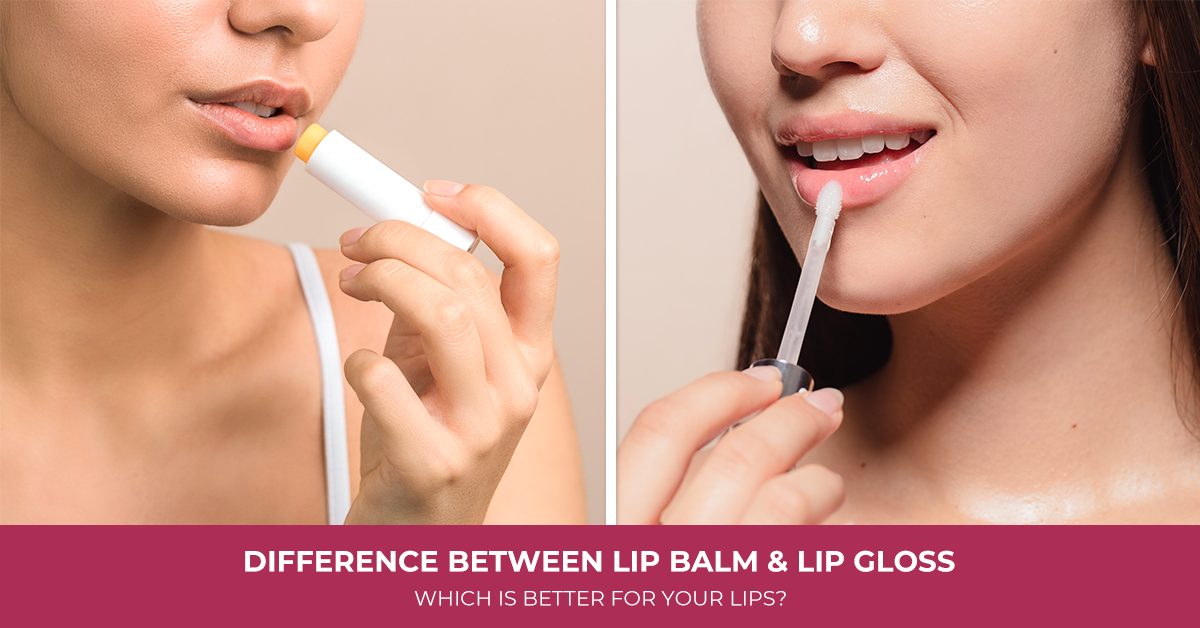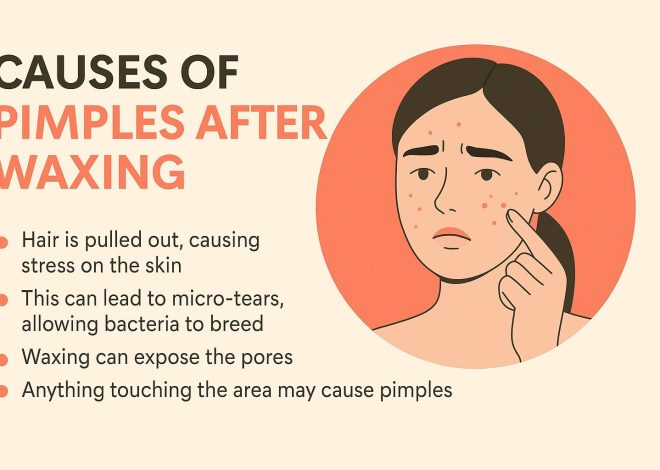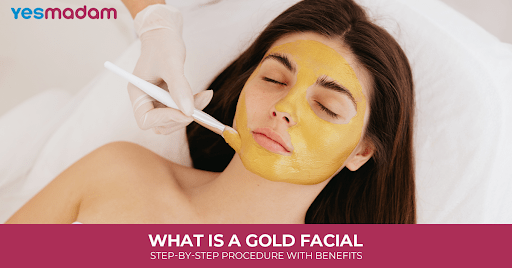
Difference Between Lip Balm and Lip Gloss: Which is Better for Your Lips?
As your lips are fragile and prone to dryness and chapping, lip care is also an important part of a skincare routine. Lip balms and lip glosses are the two most common yet popular products that come to mind when it comes to lip care and enhancement. People often confuse these terms, but each product plays a unique role in daily lip care.
In this blog, you will learn the difference between lip balm and lip gloss, delve into their unique benefits, and decide which is best suited for maintaining the health of your lips and enhancing their inherent beauty.
Table of Contents
What is Lip Gloss?
Lip gloss is a cosmetic product that is applied to the lips for shine and sometimes for color, too. It is typically available in a variety of colors, textures, and flavors to add a pop of color and make your lips appear fuller and more refined. The main goal is to improve the look of your lips, adding the look of glossiness and finish.
Related Blog: Almond Oil for Lips
What is Lip Balm?
Lip balm is a personal care product and skin protectant with a wax-like consistency that is applied to lips for moisturizing and protecting them. It is thicker than lip gloss and is found in various forms such as sticks, pots, or tubes. The main objective is to hydrate the lips, prevent dryness, and provide a barrier against environmental stressors.
Difference Between Lip Balm and Lip Gloss: A Quick Comparison
Although both lip gloss and lip balm are meant to target the area of the lips. Understanding the basic difference between lip gloss and lip balm will help you select the right product for your lip care routine.
| Feature | Lip balm | Lip gloss |
| Function | Protective and healing product to moisturize and protect lips from damage. | Cosmetic product to add shine and sometimes a subtle tint of color to lips. |
| Texture and consistency | Thicker, creamier texture or slightly waxy. | Slick, shiny, or sticky. |
| Longevity and wear | Stays longer due to its dense formulation. | Needs frequent touch-ups, especially after drinking or eating. |
| SPF protection | Comes with SPF protection against the sun. | Rarely offers this feature as the focus is on aesthetics rather than protection. |
| When to use | Daily hydration and use before bedtime help lock in moisture overnight. | Special occasions and events. |
More Information For You: Winter Lip Care Routine
What Are the Unique Benefits of Lip Balm and Lip Gloss?
The difference between lip balm and lip gloss, as discussed in the above section, indicates that lip gloss and lip balm are each important in their way to your beauty routine. To verify it, the following are the unique benefits of each lip care product:
Benefits of Lip Gloss
Wearing lip gloss provides you with several benefits. Here are some of the key lip gloss benefits for your lips:
- Hydrates and protects your lips: Lip gloss includes hydrating ingredients like emollients and natural oils, which help to hydrate and protect your lips.
- Protects your lips from the sun’s UV rays: Lip gloss also typically contains SPF, which can help to protect against harmful sun damage. Many brands of lipgloss include SPF, which helps to keep lips safe from sunburn.
- Makes your lips look fuller and plumper: Lip gloss helps improve your natural features. For example, it makes your lips fuller and plumper by adding a bit of color and shine.
- Makes you feel good: Lip gloss is a beauty product that is both practical and fun. It makes people feel good because they simply enjoy the way it feels on their lips.
Top Benefits of Lip Balm
Lip balm has a combination of immense benefits for addressing concerns of dry, chapped, and sometimes painful lips. Following are a few benefits of lip balm on dry lips:
- Hydration and moisturization: A sign of a good balm lies in its ability to hydrate and moisturize your lips. Lip balms contain ingredients to combat dry skin.
2 . Protection against harsh elements: A quality lip balm with SPF features creates the best protective barrier against the detrimental impact of UV radiation, harsh winds, and extreme temperatures.
- Prevention of chapping and cracking: Regular application of lip balm helps prevent your lips from drying out and developing painful fissures.
- Soothing relief for irritated lips: The calming and soothing ingredients in lip balm can provide much-needed relief against dry, irritated lips.
- Exfoliation and cell renewal: Some lip balms include gentle exfoliating ingredients. This, in turn, helps get rid of dead skin cells and remove flaky skin, bringing forth smoother, healthier lips.
- Improving lip health and appearance: The use of lip balms is not only good for overall lip health. But it also has aesthetic benefits, ensuring a smoother and more even coverage.
Recommended Reading: Best Lipstick Colors for Every Skin Tone
What Goes First, Lip Balm or Lip Gloss?
When applying lip products, you should always apply lip balm first before lip gloss, as the balm hydrates your lips and creates a base for the gloss to adhere to properly; essentially, you moisturize your lips before adding color or shine with gloss.
Key points:
- Hydration first: A lip balm’s primary function is to moisturize, so it’s best to apply it as the first step in your lip routine.
- Better application: Applying lip balm before gloss helps the gloss go on smoothly and evenly.
- Long-lasting wear: A well-moisturized lip can help your lip gloss stay on longer.
Lip Gloss vs. Lip Balm: Ingredients Breakdown and Uses
Lip gloss and lip balm serve different purposes and contain different ingredients tailored to their specific uses. Here’s a breakdown:
Lip Gloss Ingredients Breakdown
Lip gloss ingredients are used for adding shine, color, and a glossy finish to the lips, often as a cosmetic product. Every lipgloss brand has its combination of ingredients. The following are some common ones:
- Emollients (e.g., oils & waxes): Castor oil, mineral oil, lanolin, shea butter—to provide shine and a smooth application.
- Thickeners: Beeswax, carnauba wax, candelilla wax—to adjust texture.
- Colorants & Pigments: Mica, iron oxides, or synthetic dyes to add color.
- Flavoring & Fragrance: Mint, vanilla, or fruit extracts—for a pleasant taste and scent.
- Preservatives: Parabens, phenoxyethanol—to prevent bacterial growth.
Lip Balm Ingredients Breakdown
Similarly, different lip balm brands will have different product ingredients. Here are some common ingredients in lip balm that help to moisturize, protect, and heal dry or chapped lips.
- Occlusives: Petroleum jelly, beeswax, lanolin—to seal in moisture.
- Humectants: Glycerin, hyaluronic acid, and honey—to draw moisture into the lips.
- Emollients: Shea butter, coconut oil, cocoa butter—to soften and smooth lips.
- Healing Agents: Aloe vera, vitamin E, and allantoin—to repair cracked or dry lips.
- SPF Ingredients: Zinc oxide, titanium dioxide, avobenzone—to protect against sun damage.
- Essential Oils (Optional): Peppermint, eucalyptus—for soothing effects (can sometimes be irritating).
Conclusion
The lip balm and lip gloss difference indicates that while the purposes of both products can differ, the final choice will depend on your goals. The secret to effective lip care lies in striking the right balance between lip health and aesthetics. Applying lip balm regularly will keep your lips healthy and help create a smooth canvas on which you can apply beauty products like lip gloss.
Thus, lip care is not a game of trial and error. By understanding the difference between lip balm and lip gloss, you can make informed decisions that cater to your lifestyle and improve your beauty routine.
FAQs
Which is best, lip balm or lip gloss, for lip care?
Lip balm ought to appear on your list of preferences for lip hydration, protection, and lip health. If you prioritize aesthetics and want to add shine, dimension, or color to your lips, lip gloss is a better choice.
Can I use lip balm and lip gloss together?
Yes, you can use lip balm and lip gloss together. It’s often recommended to apply lip balm as a base before applying lip gloss to ensure your lips are properly moisturized.
What are the disadvantages of lip gloss?
Lip gloss can have some disadvantages, including short wear, stickiness, and transferability. It can also cause skin irritation or inflammation.
Can I leave lip balm overnight?
Yes! Applying lip balm overnight repairs the damaged skin and regenerates new cells for fresh and plump skin.
Is lip gloss ok for dry lips?
While some lip glosses can be okay for dry lips, it depends on the ingredients; most traditional lip glosses are not ideal for very dry lips, as they often lack sufficient moisturizing properties.
How much SPF is good for lips?
The experts recommend using lip balm with SPF 30 or higher every day. This will help protect your lips from the sun’s harmful UV rays.
How often should you apply lip gloss vs. lip balm?
You should apply lip balm much more frequently than lip gloss, as lip balm is primarily designed for hydration, while lip gloss is primarily for cosmetic shine and typically needs to be reapplied less often.
Is it OK to apply lip gloss and lip balm daily?
Yes, it is generally okay to apply both lip gloss and lip balm daily, as long as you choose products with hydrating ingredients and apply them appropriately.
Can lip gloss replace lip balm?
No, lip gloss should not be used as lip balm because it doesn’t hydrate lips. Lip balm is designed to moisturize and protect lips, while lip gloss is used for adding shine and color.
Can I apply lip gloss and lip balm directly on my lips?
Yes, you can apply both lip gloss and lip balm directly on your lips, with the general recommendation being to apply lip balm first to hydrate your lips before applying lip gloss for added shine and color.



